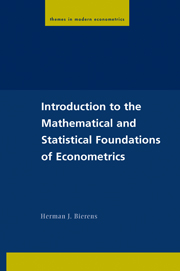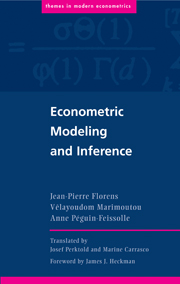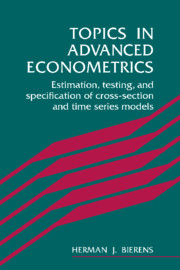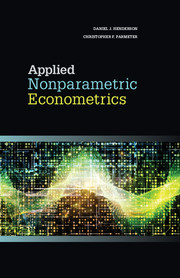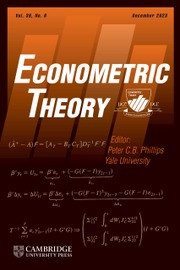Introduction to the Mathematical and Statistical Foundations of Econometrics
This book is intended for use in a rigorous introductory PhD level course in econometrics, or in a field course in econometric theory. It covers the measure-theoretical foundation of probability theory, the multivariate normal distribution with its application to classical linear regression analysis, various laws of large numbers, central limit theorems and related results for independent random variables as well as for stationary time series, with applications to asymptotic inference of M-estimators, and maximum likelihood theory. Some chapters have their own appendices containing the more advanced topics and/or difficult proofs. Moreover, there are three appendices with material that is supposed to be known. Appendix I contains a comprehensive review of linear algebra, including all the proofs. Appendix II reviews a variety of mathematical topics and concepts that are used throughout the main text, and Appendix III reviews complex analysis. Therefore, this book is uniquely self-contained.
- Rigorous and comprehensive overview of the mathematical and statistical foundations of econometrics
- The focus is on understanding 'why' rather than 'how', therefore all the proofs are provided
- Appendices contain enough advanced material to make the book suitable for a specialty course in econometric theory
Reviews & endorsements
"Overall, this is an excellent textbook. It offers a unique perspective different from the standard approach in the mainstream textbooks. It encourages the mastering of fundamental concepts and theoretical perspectives at a formal level geared to develop a 'mathematical mind'. It will prove valuable not only for graduate students in econometrics and econometric theory but also as a reference to all researchers in modern economics, econometrics, statistics and financial econometrics." - Economic Record
"One outstanding virtue of Bierens' book is the inclusion of a large number of proofs. Some are in the text, and some are relegated to chapter appendices, but in any case, these are an essential ingredient of any such text.... Taken as a whole, this book can be seen as a rather personal compendium of things that Professor Beirens regards as important for students to know. It would be difficult indeed to fit more bits of knowledge useful to the apprentice econometrician into a book of this compass. It represents both an outstanding investment for the graduate student and an item that many researchers and practitioners will find invaluable for reference." - Econometric Reviews
Product details
December 2004Paperback
9780521542241
344 pages
229 × 152 × 20 mm
0.51kg
19 b/w illus. 12 tables
Available
Table of Contents
- Part I. Probability and Measure:
- 1. The Texas lotto
- 2. Quality control
- 3. Why do we need sigma-algebras of events?
- 4. Properties of algebras and sigma-algebras
- 5. Properties of probability measures
- 6. The uniform probability measures
- 7. Lebesque measure and Lebesque integral
- 8. Random variables and their distributions
- 9. Density functions
- 10. Conditional probability, Bayes's rule, and independence
- 11. Exercises: A. Common structure of the proofs of Theorems 6 and 10, B. Extension of an outer measure to a probability measure
- Part II. Borel Measurability, Integration and Mathematical Expectations:
- 12. Introduction
- 13. Borel measurability
- 14. Integral of Borel measurable functions with respect to a probability measure
- 15. General measurability and integrals of random variables with respect to probability measures
- 16. Mathematical expectation
- 17. Some useful inequalities involving mathematical expectations
- 18. Expectations of products of independent random variables
- 19. Moment generating functions and characteristic functions
- 20. Exercises: A. Uniqueness of characteristic functions
- Part III. Conditional Expectations:
- 21. Introduction
- 22. Properties of conditional expectations
- 23. Conditional probability measures and conditional independence
- 24. Conditioning on increasing sigma-algebras
- 25. Conditional expectations as the best forecast schemes
- 26. Exercises
- A. Proof of theorem 22
- Part IV. Distributions and Transformations:
- 27. Discrete distributions
- 28. Transformations of discrete random vectors
- 29. Transformations of absolutely continuous random variables
- 30. Transformations of absolutely continuous random vectors
- 31. The normal distribution
- 32. Distributions related to the normal distribution
- 33. The uniform distribution and its relation to the standard normal distribution
- 34. The gamma distribution
- 35. Exercises: A. Tedious derivations
- B. Proof of theorem 29
- Part V. The Multivariate Normal Distribution and its Application to Statistical Inference:
- 36. Expectation and variance of random vectors
- 37. The multivariate normal distribution
- 38. Conditional distributions of multivariate normal random variables
- 39. Independence of linear and quadratic transformations of multivariate normal random variables
- 40. Distribution of quadratic forms of multivariate normal random variables
- 41. Applications to statistical inference under normality
- 42. Applications to regression analysis
- 43. Exercises
- A. Proof of theorem 43
- Part VI. Modes of Convergence:
- 44. Introduction
- 45. Convergence in probability and the weak law of large numbers
- 46. Almost sure convergence, and the strong law of large numbers
- 47. The uniform law of large numbers and its applications
- 48. Convergence in distribution
- 49. Convergence of characteristic functions
- 50. The central limit theorem
- 51. Stochastic boundedness, tightness, and the Op and op-notations
- 52. Asymptotic normality of M-estimators
- 53. Hypotheses testing
- 54. Exercises: A. Proof of the uniform weak law of large numbers
- B. Almost sure convergence and strong laws of large numbers
- C. Convergence of characteristic functions and distributions
- Part VII. Dependent Laws of Large Numbers and Central Limit Theorems:
- 55. Stationary and the world decomposition
- 56. Weak laws of large numbers for stationary processes
- 57. Mixing conditions
- 58. Uniform weak laws of large numbers
- 59. Dependent central limit theorems
- 60. Exercises: A. Hilbert spaces
- Part VIII. Maximum Likelihood Theory
- 61. Introduction
- 62. Likelihood functions
- 63. Examples
- 64. Asymptotic properties if ML estimators
- 65. Testing parameter restrictions
- 66. Exercises.

